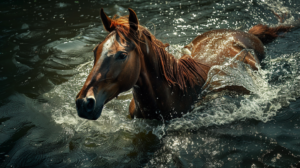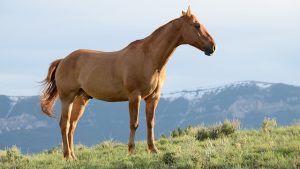In the world of equine care and hoof health, the role of a farrier is indispensable. This ancient craft combines elements of blacksmithing, veterinary science, and specialized horse care, making it a crucial part of ensuring the well-being and performance of horses. If your horse is dealing with hoof chips and cracks or having trouble walking on slippery surfaces, don’t wait for health problems like fatigue or injuries to arise. As the saying goes, it’s better to prevent than cure. One of the best ways to avoid these issues is to have a farrier inspect your horse’s hooves, clean them, shape them, and fit snug new horseshoes.
I once saw a farrier working on a Thunder horse at my friend’s farm. An experienced man, the farrier, carefully trimmed and shaped Thunder’s hooves. Then I realized that regular visits from a farrier are crucial for maintaining a horse’s hoof health, which is essential to owning a horse and ensuring its well-being despite the associated costs. At some point, horses may experience hoof problems, ranging from minor issues to serious conditions affecting their ability to walk and perform tasks. According to the American Farrier’s Association, proper hoof care is essential as it directly impacts a horse’s comfort and mobility.
But what is a farrier, and how can they help your horses? This article will discuss what farriers are and how these hoof-care experts can help keep your horse in the best condition. We will also share the benefits of getting your horse a horseshoe from a professional Farrier. Let’s dive right in.
What is a Farrier?
A farrier is a skilled professional responsible for caring for and maintaining horses’ hooves and sometimes their shoes. This ancient craft plays a crucial role in ensuring the health and performance of horses. Farriers trim and shoe horses and diagnose and treat hoof-related ailments, playing a pivotal role in equine welfare.
Quick fact: Most of the farriers are self-employed. This profession offers them a flexible schedule, so some farriers opt to travel and provide services to different horses that compete across the country.
But what is entailed in their jobs, and how can they help your horses? Let’s dig into that further.
What Does a Farrier Do?
A farrier’s job is physically demanding because they must stand long while bending and lifting the horse’s leg. Plus, the shoes they fit are unique to every animal.
Farriers often shape horseshoes through two different processes. The first method is cold shoeing, which requires the metal to be beaten into shape while cold. The second one is hot shoeing, where the farrier must form the shoes while the metal is hot.
But that is just a part of the shoeing process. Their job typically includes the following:
- Discuss and agree with the owner about shoeing requirements.
- Check the general health of the horse’s foot, leg, and hoof, removing the excess hoof growth.
- Evaluate the horse’s gait, hoof balance as well as conformation.
- Choose the shoe that best suits the horse’s size, foot condition, type of activity, and working conditions.
- Create horseshoes either by hand or machine.
- Adjust the shape of the shoes with a hammer and anvil
- Change and fit the new horseshoes.
How Does a Farrier Work?
Horses require trimming every six to eight weeks to help them keep the balance and stability of their feet and lower limbs. This task is challenging as horses are huge and powerful animals. They also need different tools, such as rasps and nippers, to trim and shape the hooves. They also need to make some adjustments and reshaping before finally applying horseshoes.
You can buy horseshoes in different sizes, weights, and designs on the market. But if you want a horseshoe that snugly fits into your horse’s hooves, it would be best to ask farriers with skills in ironwork to make durable custom shoes. They can assess the conformation, gait, and hoof balance when deciding what adjustments to make. Thus, a horseshoe is essential for your horse.
Discover the advantages of applying horseshoes on your horse’s hoof and how it can keep your horse active and healthy.
The Benefits of Horseshoeing
Taking proper care of your horse’s hoof is vital, especially if your horse has an active work life, weak feet, or other hoof problems. However, it is not easy, and it requires a considerable amount of time as you need to get its feet trimmed every six to eight months, and you also have to put the horseshoes on or replace them if the farrier deems it necessary. But, your horse can significantly benefit from wearing horseshoes provides the following advantages:
It protects your horse’s hooves:
Horse’s hooves are prone to chipping and cracks due to frequent riding on hard surfaces. That’s why you need to protect their feet with a horseshoe: it can help absorb a considerable amount of impact when it takes a step, preventing the hooves from getting chipped. You can then be at ease because the crucial part of their feet is well-protected.
Adds extra traction:
Horses sometimes walk on slippery surfaces, and that’s where horseshoes, studs, and other devices come in. It can add extra traction and significantly improve the ability of your horse to grip the ground without slipping or sliding. Thus, it benefits competitive horses like racehorses, jumpers, and polo ponies.
Corrects several hoof problems:
Horseshoes are mostly designed to fix specific hoof problems. Some are used to keep the medicine on the hoof, others prevent the hoof from getting bruised and damaged, while some shoes change the shape and angle of the horse’s hoof. Corrective shoeing can also improve the quality of a horse’s life because it helps horses with genetic deformities like clubfoot to remain sound and able to work.
Alters the horse’s gait:
Your horse’s gait can be altered with extreme shoeing modifications. By simply changing the height and angle of the hoof, the way your horse moves, walks, trots, and gallops would also change. This is essential in competitions where trainers and exhibitors often employ a particular type of shoe to their gaited horse breeds to magnify and amplify their gaits.
So that explains what farriers do and how they are essential in keeping your equines healthy and in sound mind. Their work is not just limited to shoeing because their services also include trimming and cleaning of hoofs. Furthermore, horse owners can also consult farriers for recommendations regarding hoof care products, feeding, supplements, and even fly sprays. So, asking trusted Farriers can be very beneficial if you have any questions regarding hoof care.





